ARTICLE AD BOX

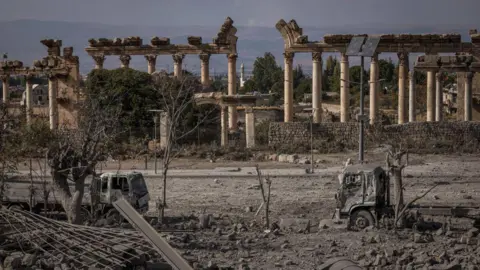 Getty Images
Getty Images
A car park close to Baalbek's Unesco-designated Roman ruins was hit in an Israeli air strike
For over two millennia, the Roman temples at Baalbek in eastern Lebanon have stood as some of the finest examples of Roman architecture anywhere in the world.
On Wednesday, a car park just metres away from the Unesco World Heritage site was hit by an Israeli air strike.
The attack, which also destroyed a centuries-old Ottoman building, highlighted what some archaeologists say is the risk of irreparable damage to historical sites across Lebanon from the current war between Israel and Hezbollah.
"Baalbek is the major Roman site in Lebanon. You couldn't replace it if someone bombed it," says Graham Philip, an archaeology professor at Durham University.
"It would be a huge loss. It would be a crime."
Since late September, Israel has pummelled Lebanon with thousands of air strikes in an escalation of its campaign against Hezbollah, the Iran-backed group it has been fighting in nearly a year of cross-border strikes.
The Israel Defense Forces (IDF) has largely been targeting southern Lebanon, suburbs in the capital Beirut and the eastern Bekaa Valley.
But in the past fortnight, the campaign has moved into new areas, or rather, very old ground.
The IDF told the BBC that it only targets military sites. But those targets are incredibly close to the Baalbek temples and Roman ruins in Tyre, a major port of the Phoenician Empire around 2,500 years ago.
According to legend, Tyre is the place where purple pigment was first created - the dye crushed out of snail shells to embroider royal robes.
On 23 October, the IDF issued evacuation orders for neighbourhoods close to the city's Roman ruins, including the remains of a necropolis and a hippodrome.
Hours later it began striking targets. More bombing of the sites was reported last week.
Videos from the strikes showed huge clouds of black smoke rising from seafront areas only a few hundred metres from the ruins.

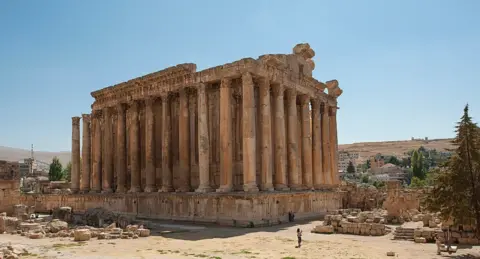 UNESCO
UNESCO
Unesco says the Temple of Bacchus in Baalbek is one of the world's finest examples of Imperial Roman architecture
There is no evidence that the Roman sites in Tyre and Baalbek have been damaged by the Israeli strikes. But Lebanese archaeologists are alarmed at how close the fighting has been to the millennia-old ruins, recognised by Unesco as having outstanding value to humanity.
"For Baalbek it was even worse than Tyre, because the temples are located within the area that is targeted and [the IDF] did not make any exemption for the temples," says local archaeologist Joanne Farchakh Bajjaly.
She says there are no Hezbollah facilities at the Baalbek site: "No one knows what the excuse or the message behind the hit is."
The IDF disputes this. In a statement, it told the BBC it targets military sites in accordance with strict protocol, adding that it is "aware of the existence of sensitive sites and this is taken into account and constitutes an essential part of the planning of strikes".
"Each strike that poses a risk to a sensitive structure is weighed carefully and goes through a rigorous approval process as required."

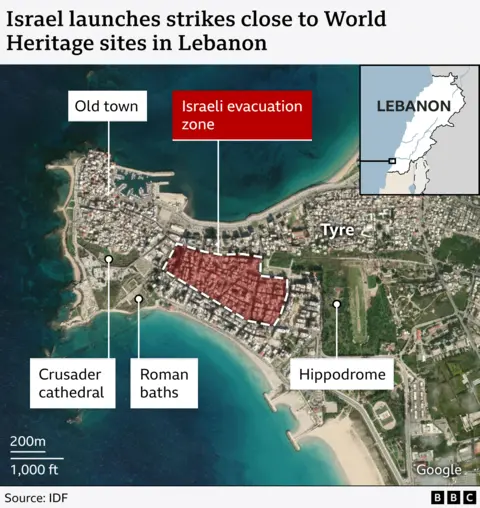
Israel released target zones for Tyre on 23 October which included settlements near the ancient ruins but not the Unesco site itself or the Old Town
Some ordinary Lebanese attempting to escape Israeli bombing reportedly fled to the Baalbek ruins, judging that ancient sites would not be targeted by Israel and would therefore offer protection.
Ms Farchakh Bajjaly says "those who didn't have a car to flee" moved closer to the ruins, in the belief that the Unesco sites are considered more valuable than their lives.
It prompted the local government to issue a warning urging people against travelling to the ruins.
"They see the site as their shelter. But the site is not a shelter," Ms Farchakh Bajjaly says.
The war puts Israel in a "difficult situation", says Israeli archaeologist Erez Ben-Yosef.
He said that war damage to important archaeological sites would be a "huge loss to the cultural heritage of Lebanon and indeed the entire world.
"However, I know personally that Israel is doing everything it can to prevent such damage.
"Many of my fellow archaeologists, both colleagues and students, serve in the army and participate in the war... they actively work to prevent such damage, in accordance with the general guidelines of our military."

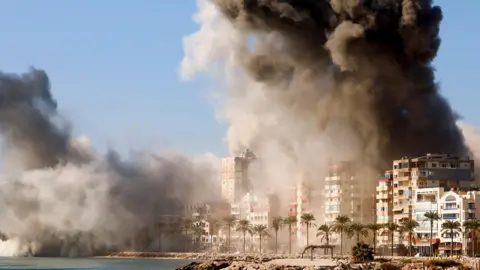 Reuters
Reuters
Smoke billowed out over the port city of Tyre
Graham Philip, the Durham University archaeology professor, says he doesn’t believe Israel would intentionally hit Baalbek or other sites.
"It's hard to see what they would gain in a military sense, bombing a Roman temple."
But he cautioned about the risk of some bombs or missiles going off target and hitting the ruins, even unintentionally: "If you drop enough ordnance, not all of that lands within 25 metres of the target."
Mr Philip has been closely monitoring the impact of Israel's strikes on heritage sites in Gaza where it is fighting Hamas, leading a British university team documenting archaeological destruction across the territory.
He says it is still too early to assess how much damage has been done by the current wars in Lebanon and Gaza. But a Unesco survey published in September found that 69 cultural heritage sites in Gaza had been damaged by the war, which was triggered by the Hamas attacks of 7 October 2023.
The oldest mosque in Gaza, the Great Omari Mosque, is one. It was built on the site of an ancient Philistine temple before being converted into a church and then a mosque. It was reportedly mostly destroyed by an Israeli strike in December 2023.
Mr Philip says these ancient sites are not only important anchors to the classical past, but are "almost like the soul of a population".
"Imagine how people would feel in Britain if the Tower of London or Stonehenge were destroyed.
"It's part of their identity."

 2 months ago
12
2 months ago
12
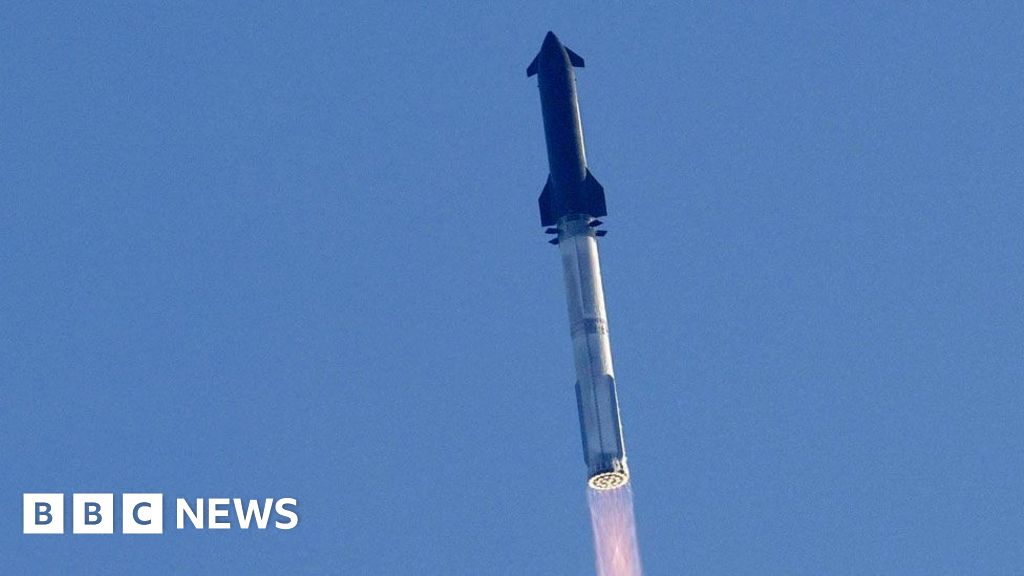

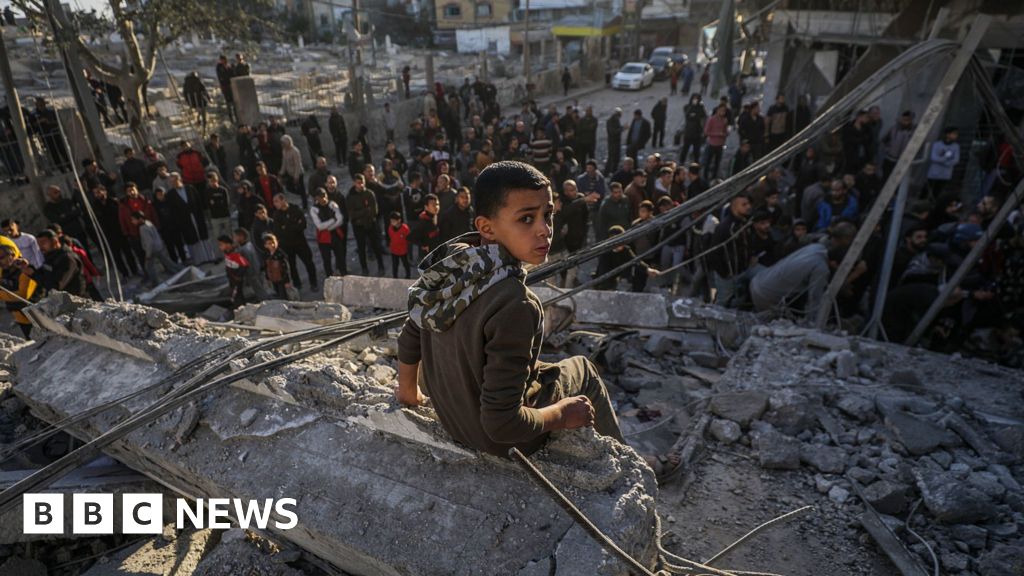





 English (US) ·
English (US) ·